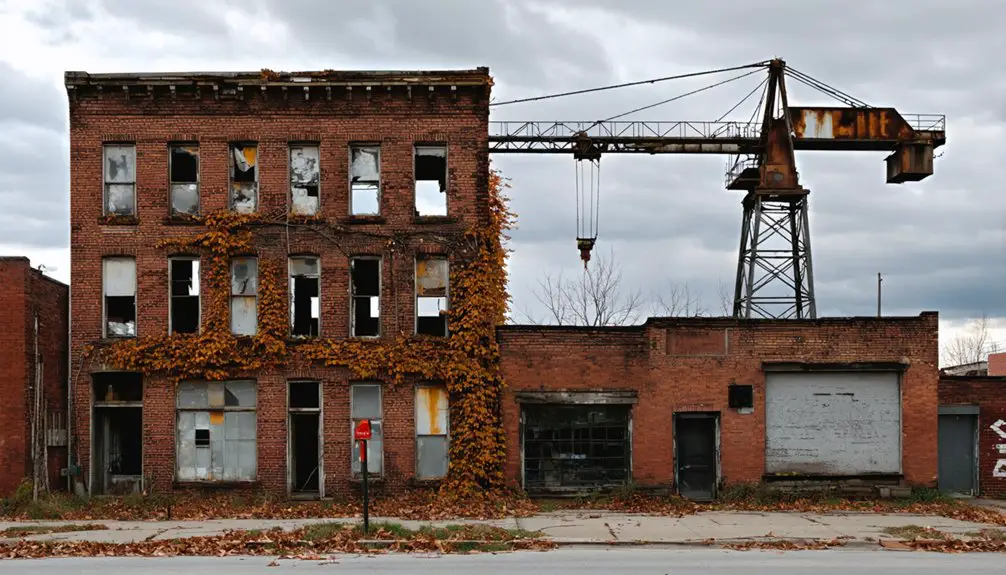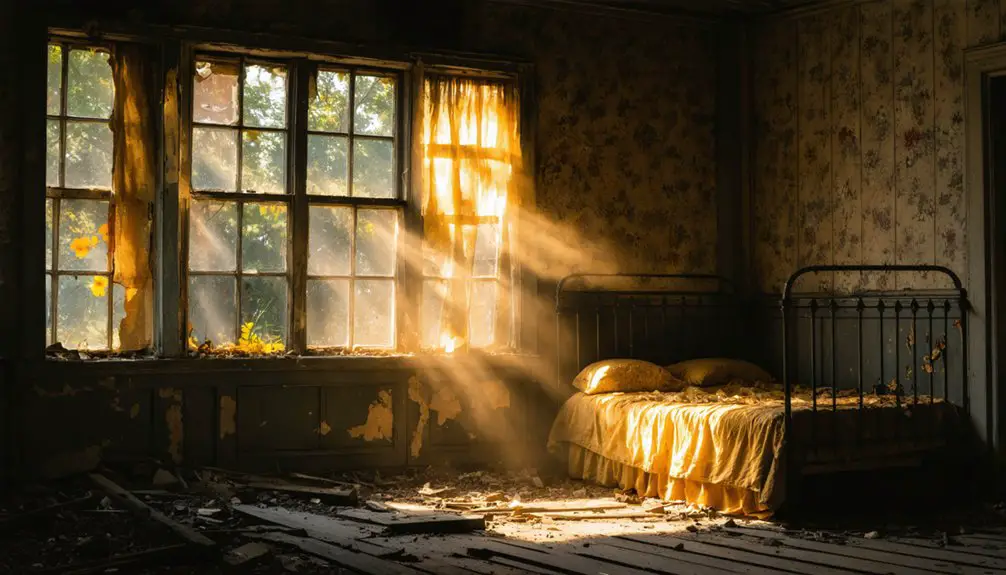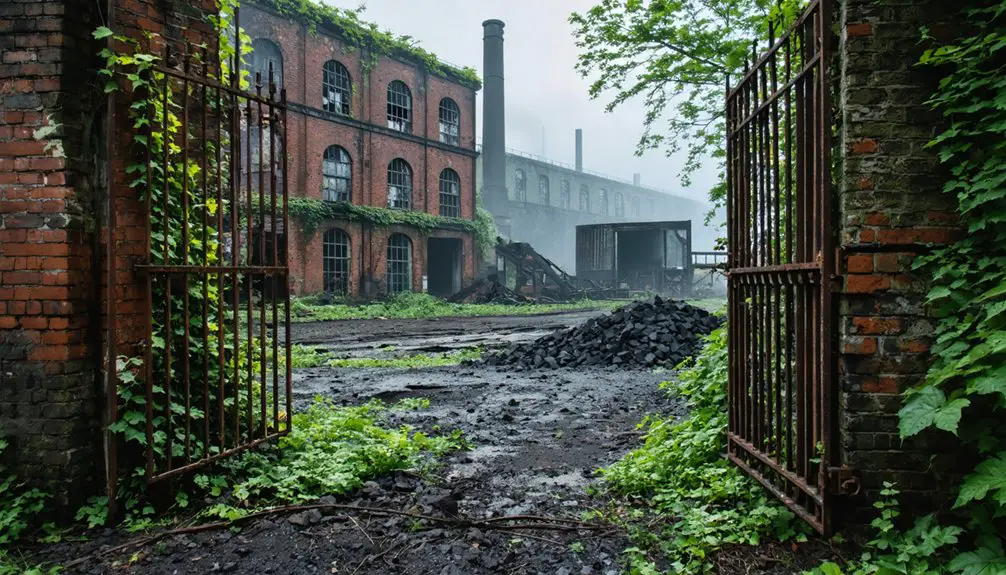You’ll find Breisons No. 3 in Fayette County, Pennsylvania, where coal mining operations once thrived in the early 1800s. The town developed around room-and-pillar mining, with beehive ovens transforming coal into valuable coke for the steel industry. Underground fires and severe environmental hazards forced residents to abandon their homes in the late 20th century. Today, nature reclaims the scattered industrial ruins, while toxic contaminants and unstable foundations tell a cautionary tale of industrial progress.
Key Takeaways
- Breisons No. 3 was a Pennsylvania coal mining town established in the early 1800s that focused on room-and-pillar mining operations.
- Underground fires, mine collapses, and severe environmental hazards forced residents to abandon the town in the late 20th century.
- The state allocated $42 million for property acquisition and invoked eminent domain due to safety concerns from underground fires.
- Remnants include concrete platforms, rusted mining equipment, church foundations, and scattered industrial artifacts amid overgrown landscape.
- The site now serves as an educational resource about Pennsylvania’s coal mining heritage and the decline of coal-dependent communities.
The Rise of a Mining Community
While Pennsylvania’s coal mining history stretches back to colonial times, Breisons No. 3’s story began during the early 1800s amid Fayette County’s burgeoning coking industry.
You’ll find its roots in the region’s rich bituminous coal seams, ranging from 24 to 72 inches thick, that attracted early industrialists like Isaac Meason. Jesse Fell’s discovery in 1808 revolutionized coal burning by introducing an effective iron grate system.
The community development centered around room-and-pillar mining operations, where labor dynamics shaped the town’s growth. The mining technique allowed workers to extract between 35 to 70 percent of available coal while maintaining structural support.
As railroads expanded access to broader markets, Breisons No. 3 emerged as one of many company towns supporting coal extraction and coke production.
The settlement’s infrastructure grew systematically – from basic mining lanes to housing developments and social institutions – all carefully planned around the workforce’s needs and the demands of the expanding steel industry.
Life in the Coal Town
As coal dust settled daily on the modest company houses of Breisons No. 3, life revolved around the mine’s unrelenting schedule and the harsh realities of industrial-era existence.
You’d wake before dawn, sending your men and boys into the dangerous depths while keeping a constant vigil for the dreaded accident whistle. By the late 1970s boom, families saw renewed prosperity as energy demands drove increased coal production.
Your world centered on the company store where you’d reluctantly purchase goods on credit, knowing each item deepened your family’s debt.
Yet you’d find strength in community events – church gatherings, ethnic festivals, and union meetings in makeshift halls. Like the residents of Centralia nearby, your community faced the daily struggles of life in Pennsylvania coal country.
This social cohesion became your lifeline. Despite the company’s iron grip on housing and wages, you’d preserve your immigrant traditions through shared meals, music, and the unspoken understanding that survival meant standing together against the crushing weight of corporate control.
Industrial Infrastructure and Operations
Since the late 1700s, the coal operations at Breisons No. 3 exemplified Pennsylvania’s bituminous mining evolution through its extensive infrastructure network.
You’d find room-and-pillar mining methods powering the drift mines that dotted the hillsides, while stone beehive ovens transformed raw coal into valuable coke for the steel industry. These industrial advancements revolutionized local production capabilities.
The mine’s sophisticated transport system connected directly to major rail networks and rivers, ensuring efficient delivery to Pittsburgh’s hungry steel mills.
You can trace how the operation’s impact extended beyond mere coal extraction – from the coal breakers that processed raw materials to the multiple work shifts that kept the community employed.
The mine’s integration with ironworks and coke plants created a powerful economic engine that shaped southwestern Pennsylvania’s industrial landscape.
Environmental Challenges and Hazards
Despite decades of abandonment, Breisons No. 3 grapples with severe environmental hazards that you’ll find typical of Pennsylvania’s ghost mining towns. The site’s toxic contaminants, including heavy metals and chemical byproducts, continue to threaten local ecosystems through multiple exposure routes.
You’ll notice the telltale orange staining of acid mine drainage in nearby waterways, where sulfide mineral oxidation creates acidic conditions that harm aquatic life and degrade water quality. These substances require strict oversight under environmental hazard regulations. Property owners must submit point-source emissions data to the Department for comprehensive monitoring of discharge impacts.
The environmental legacy extends beyond water pollution. You’re likely to encounter contaminated soil from mining residues, while groundwater faces ongoing risks from waste pile leachate.
Mining’s toxic fingerprint lingers in tainted soils and threatened groundwater, as waste piles continue releasing harmful chemicals into the environment.
During dry seasons, you might spot fugitive dust from abandoned infrastructure and tailings, carrying hazardous particles that further spread contamination throughout the surrounding landscape.
The Decline and Exodus

The environmental hazards that plagued Breisons No. 3 directly precipitated its dramatic population decline during the late 20th century.
You’d have witnessed the town’s steady disintegration as underground fires and mine collapses forced residents to abandon their homes.
Similar to nearby Landing Tavern, the economic consequences rippled through the community as property values plummeted and businesses shuttered their doors. Similar to Centralia, Pennsylvania, toxic gases escaped from the ground, making the air dangerous to breathe.
Remnants and Ruins Today
If you walk through Breisons No. 3 today, you’ll find only a handful of standing structures, including the municipal building and firehouse near the town’s central intersection.
Scattered throughout the surrounding woods, rusted rail spikes and industrial platforms hint at the area’s coal mining past, while remnants of makeshift ladders and platforms constructed from repurposed materials tell stories of later adaptations.
Most buildings have succumbed to extensive fire damage, leaving behind scorched wood, melted metal, and unstable foundations that serve as stark reminders of the town’s fate. Like nearby Centralia, toxic gases and intense heat from underground coal fires continue to impact the abandoned landscape. Similar to what happened in Ashlin, the town experienced a sharp decline when mining operations ceased, leading to widespread abandonment of homes and businesses.
Visible Structural Features Today
While walking through Breisons No. 3 today, you’ll encounter a haunting array of structural remnants that paint a portrait of this once-thriving mining community. You’ll find concrete foundations peeking through thick vegetation, telling stories of abandoned structures and community memories. Scattered throughout the landscape, partially intact brick walls and weathered chimneys stand as silent witnesses to former homes and businesses.
- Crumbling porch steps and fragmented sidewalks reveal the original street layout, now barely recognizable beneath nature’s reclamation.
- Large concrete platforms mark where mining operations once processed coal, with rusty rail fragments nearby.
- Historic utility poles lean at precarious angles, while scorched earth patches hint at the underground fires below.
- Church and school foundations remain visible, their weathered stone still defining community gathering spaces.
Mining Equipment Left Behind
Rusted remnants of Breisons No. 3’s mining operations lie scattered across the abandoned landscape, telling stories of the site’s industrial past.
You’ll find lever-operated mechanisms still attached to crumbling walls, while fragments of coal-cutting apparatus rest among overgrown debris. The ghostly remains of loading stations feature mechanical linkages that once transported coal through the complex.
Inside partially collapsed structures, you can spot evidence of early 20th-century mining technology – control levers, rail connections, and remnants of thermal equipment from old furnace rooms.
While no intact heavy machinery remains, abandoned machinery pieces dot the grounds, from overturned mine cars to scattered parts of conveyor systems.
Coal dust still clings to the ruins of processing areas, where workers once sorted and prepared coal for shipment.
Historical Significance and Legacy

Breisons No. 3 stands as a powerful symbol to Pennsylvania’s coal mining heritage and the broader narrative of America’s industrial transformation.
You’ll discover a rich cultural heritage that reflects the rise and fall of coal-dependent communities in the Rust Belt, where mining techniques evolved alongside immigrant labor forces that shaped early industrial America.
- The town’s story exemplifies the dramatic economic shifts from thriving industrial mining economies to post-industrial abandonment.
- You’ll find preserved remnants that serve as a living classroom for historians and industrial archaeologists.
- The site continues to influence modern policies on mine reclamation and community relocation.
- Local historical societies maintain archives documenting the community’s significant role in Pennsylvania’s coal industry.
The legacy of Breisons No. 3 offers vital lessons about sustainable development and the true cost of industrial progress.
Legal Status and Property Rights
The legal status of Breisons No. 3 follows a complex pattern of property rights and government intervention that’s shaped its modern existence.
Like its neighbor Centralia, the town faced significant legal complexities when Pennsylvania invoked eminent domain to address safety concerns from underground mine fires.
You’ll find that property disputes emerged as residents fought against government buyouts, leading to prolonged legal battles throughout the 1990s.
The state’s $42 million allocation for property acquisition and resident relocation met resistance from homeowners who believed they were being unlawfully pushed off their land.
While most eventually accepted buyouts, some holdouts secured temporary ownership rights through a 2013 settlement, though these properties would revert to state control upon the owners’ death.
Today, most parcels remain state-owned, with redevelopment strictly prohibited.
Frequently Asked Questions
Are There Any Documented Paranormal Activities or Ghost Sightings in Breisons No. 3?
You won’t find any officially documented ghost stories or spectral sightings here, though nearby Centralia’s paranormal reputation and Pennsylvania’s mining heritage often inspire similar tales in abandoned communities like this.
What Happened to the Town’s Cemetery and Burial Records?
Like whispers in time, you’ll find the cemetery’s fate remains uncertain. Records likely scattered when the town died, with burial practices and cemetery preservation efforts leaving minimal documented traces in accessible archives.
Did Any Notable Crimes or Murders Occur in Breisons No. 3?
While local legends hint at unsolved mysteries, there’s no historical evidence of notable crimes or murders in this town. You won’t find documented records of violent incidents during its mining years.
Were There Any Major Mining Disasters Specific to Breisons No. 3?
You won’t find records of major mining disasters at this site, despite the era’s typical mining safety concerns. While disasters struck other Pennsylvania mines, documented evidence doesn’t show catastrophic events here involving disaster prevention failures.
What Happened to the Town’s Historical Artifacts and Photographs?
You’ll find local residents and organizations preserved some artifacts and historical documentation, while underground fires and landscape changes buried others. Environmental damage destroyed many physical remnants, though some photos survive in archives.
References
- https://www.youtube.com/watch?v=Qj5LjacccJ0
- https://www.youtube.com/watch?v=_u5MUuwynhw
- https://en.wikipedia.org/wiki/List_of_ghost_towns_in_Pennsylvania
- https://en.wikipedia.org/wiki/Centralia
- https://www.youtube.com/watch?v=fm3wxSOqlYM
- http://amrclearinghouse.org/Sub/SCARLIFTReports/Redstone/Chapter 3.pdf
- https://www.pa.gov/agencies/dep/programs-and-services/mining/bureau-of-mining-programs/pa-mining-history.html
- https://elibrary.dcnr.pa.gov/PDFProvider.ashx?action=PDFStream&docID=1752502&chksum=&revision=1&docName=al_Pa&nativeExt=pdf&PromptToSave=False&Size=1731267&ViewerMode=2&overlay=0
- https://en.wikipedia.org/wiki/History_of_anthracite_coal_mining_in_Pennsylvania
- http://www.coalmininghistorypa.org/annualreport/1938/1938_bit/1938_bituminous.pdf



